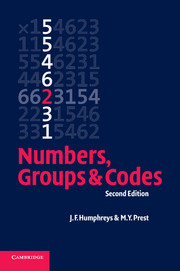Book contents
- Frontmatter
- Contents
- Preface to first edition
- Preface to second edition
- Introduction
- Advice to the reader
- 1 Number theory
- 2 Sets, functions and relations
- 3 Logic and mathematical argument
- 4 Examples of groups
- 5 Group theory and error-correcting codes
- 6 Polynomials
- Appendix on complex numbers
- Answers
- References and further reading
- Biography
- Name index
- Subject index
1 - Number theory
Published online by Cambridge University Press: 05 September 2012
- Frontmatter
- Contents
- Preface to first edition
- Preface to second edition
- Introduction
- Advice to the reader
- 1 Number theory
- 2 Sets, functions and relations
- 3 Logic and mathematical argument
- 4 Examples of groups
- 5 Group theory and error-correcting codes
- 6 Polynomials
- Appendix on complex numbers
- Answers
- References and further reading
- Biography
- Name index
- Subject index
Summary
This chapter is concerned with the properties of the set of integers {…, −2, −1, 0, 1, 2, …} under the arithmetic operations of addition and multiplication. We shall usually denote the set of integers by ℤ. We shall assume that you are acquainted with the elementary arithmetical properties of the integers. By the end of this chapter you should be able to solve the following problems.
What are the last two digits of 31000?
Can every integer be written as an integral linear combination of 197 and 63?
Show that there are no integers x such that x5 − 3x2 + 2x − 1 = 0.
Find the smallest number which when divided by 3 leaves 2, by 5 leaves 3 and by 7 leaves 2. (This problem appears in Sūn tzĭ suàn jīng (Master Sun's Arithmetical Manual) which was written around the fourth century.)
How may a code be constructed which allows anyone to encode messages and send them over public channels, yet only the intended recipient is able to decode the messages?
The division algorithm and greatest common divisors
We will assume that the reader is acquainted with the elementary properties of the order relation ‘≤’ on the set ℤ. This is the relation ‘less than or equal to’ which allows us to compare any two integers.
- Type
- Chapter
- Information
- Numbers, Groups and Codes , pp. 1 - 77Publisher: Cambridge University PressPrint publication year: 2004



